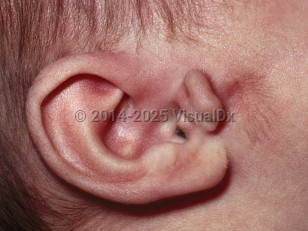Goldenhar syndrome, also known as oculo-auriculo-vertebral dysplasia, is primarily a craniofacial malformation disorder, but many patients have skeletal, cardiac, and cognitive signs as well. The facial malformations are often asymmetric (hemifacial or craniofacial microsomia). This congenital disorder is clinically heterogeneous, and the signs vary widely from case to case. Goldenhar syndrome is rare, present in only 1 of every 3500-25 000 newborns.
The abnormalities are found mainly in the ears, vertebrae, heart, and ocular structures, as this is a developmental malformation of the first and second branchial arches. Craniofacial abnormalities may include preauricular skin tags, microtia, anotia, and microphthalmia. Vertebrae, central nervous system, and cardiac structures may also be involved. However, many patients lead normal lives with a normal level of intelligence.
Most cases occur sporadically, but some familial cases suggest autosomal dominant inheritance in 1%-2% of instances.
Goldenhar syndrome in Adult
Alerts and Notices
Important News & Links
Synopsis

Codes
ICD10CM:
Q87.0 – Congenital malformation syndromes predominantly affecting facial appearance
SNOMEDCT:
205418005 – Goldenhar syndrome
Q87.0 – Congenital malformation syndromes predominantly affecting facial appearance
SNOMEDCT:
205418005 – Goldenhar syndrome
Look For
Subscription Required
Diagnostic Pearls
Subscription Required
Differential Diagnosis & Pitfalls

To perform a comparison, select diagnoses from the classic differential
Subscription Required
Best Tests
Subscription Required
Management Pearls
Subscription Required
Therapy
Subscription Required
References
Subscription Required
Last Updated:01/16/2022

